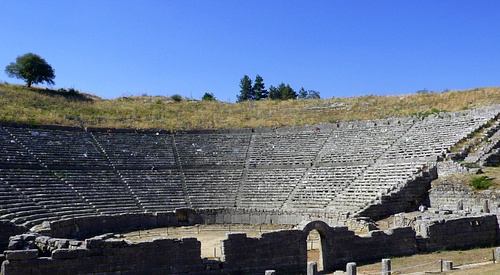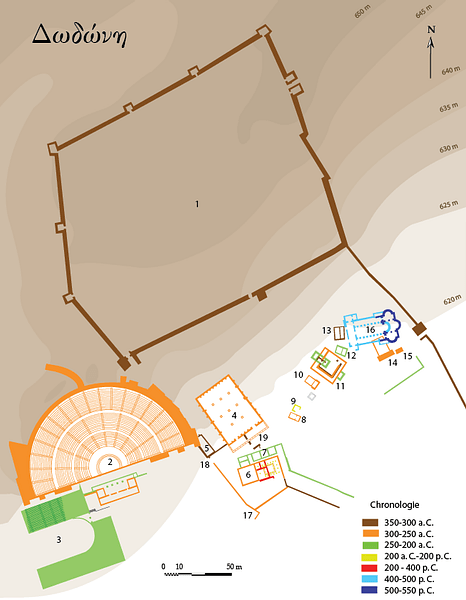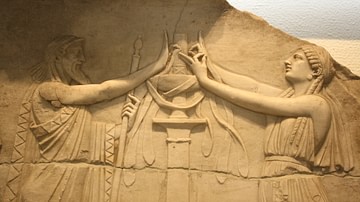
Dodona in Epirus, north-west Greece, lies in a valley on the eastern slopes of Mt. Tomaros and was famed throughout the ancient Greek world as the site of a great oracle of Zeus. The site was expanded in the Hellenistic period, and one of the largest theatres in Greece was built which, recently restored, stands as testimony to Dodona's importance throughout antiquity.
Historical Overview
The origin of the name Dodona is uncertain but may derive either from the Oceanid nymph of the same name or the river Dodoni. First settled in the early Bronze Age, Dodona benefitted from a "hundred springs", and there is some evidence of an early chthonian cult to a fertility/Mother earth goddess, which is consistent with Hesiod's description of a Great Goddess who fed her worshippers roasted acorns and a scene on a Mycenaean gold ring excavated at the site. Bronze weapons and pottery finds further indicate Dodona was inhabited in Mycenaean times (from the 15th century BCE), but the site gained wider celebrity in the Archaic and Classical periods as a sanctuary to Zeus Naïos (Dweller) and Dione Naïa, both of whom appeared side by side on coins of Dodona and who were reincarnations of the earlier sky/storm god and fertility goddess, respectively.
In Hellenistic times Pyrrhus (319-272 BCE), the king of Epirus, made Dodona his religious centre, inaugurated the festival of the Naïa in honour of Zeus, and constructed a large theatre and a colonnaded precinct. Pyrrus also famously hung shields in the precinct of the Romans and Macedonians he had defeated in battle. The fortunes of Dodona took a turn for the worse in 219 BCE when it was sacked by the Aetolians. Revenge was taken in 218 BCE and the site rebuilt on a larger scale. Dodona once again suffered attack in 167 BCE, when the Romans conquered Epirus and burnt down the sanctuary. The Naïa festival was, however, revived and continued to be held up to the 3rd century CE. The sanctuary ceased to function as a pagan site in the 4th century CE following the decree of Theodosius, and the oak tree was uprooted. In the 5th-6th century CE a Christian Basilica was built. In the mid-6th century CE, following the Slav invasion, the site was definitively abandoned.
The Oracle of Dodona
The oracle at Dodona was considered the oldest in Greece, even if it was later replaced in importance by the oracle of Apollo at Delphi. According to Herodotus (Histories 2.57) the oracle was founded when two black doves flew from Thebes in Egypt; one dove settled in Libya to found the sanctuary of Zeus Ammon, and the other settled in an oak tree at Dodona, proclaiming a sanctuary to Zeus be built there.
In Greek mythology the oracle was visited by notable heroes, such as Jason, who was told by Hera to place a protective branch from the sacred oak tree on the prow of his ship the Argo before he set off on his search for the Golden Fleece. In Homer's Iliad Achilles, too, called on the help of Zeus Dodonean during the Trojan War in order to protect Patroclus in his fight against Hektor. In the Odyssey the hero Odysseus also consults the oracle to discover if he should return to Ithaca as himself or in disguise. Historical figures who are known to have consulted the oracle include Agesilaus, king of Sparta, and the Roman emperor Julian.
Traditionally Zeus answered questions from pilgrims via the rustling of leaves or doves (Peleiades) in his sacred oak tree which was encircled with bronze tripod cauldrons (fragments of which survive). The bronze tripods all touched and so could create a circle of sound which rang continuously, both protecting the site from evil and providing another source of Zeus' communication with humanity. Amongst the Greeks, the ringing sound the tripods produced gave rise to the expression a "Dodonian chatterbox". From the 4th century BCE, a small temple (Hiera Oikia) was constructed next to the tree, and a wall with a southern entrance was built to encircle the oak tree, replacing the ring of bronze tripods. A bronze statue of a boy holding three chains of knuckle bones was set up by admirers from Corcyra, and when the wind blew, the chains knocked against a cauldron so that the tree maintained its protective ringing. In the 218 BCE re-building programme, the Hiera Oikia was extended, with a colonnaded courtyard and monumental entrance added.
The sanctuary was maintained by an order of priests known as the Selli (or Helli) who were known to sleep on the ground and had unwashed feet so that they might more directly draw their power from the earth. From the 5th century BCE, three priestesses guarded the oracle, later to be known as the three "Doves", and who interpreted and passed on the god's responses in a state of trance, as at Delphi. These priestesses are named by Herodotus as Promeneia, Timarete, and Nicandre. Unlike at Delphi, where the oracle was often consulted on important matters of state, the oracle at Dodona was typically used to settle more private matters. Believers would write their question on a tablet and receive a simple yes or no in response.
Archaeological Remains
Remains of several primitive Bronze Age huts, one with a floor kiln, have been excavated at the site. Various remains survive from the 4th century BCE Hiera Oikia which stood by the sacred oak tree and which was developed in four distinct phases to eventually measure 20.8 x 19.2 metres. There is also the 9.8 x 9.4 metre base of the 4th century BCE temple of Dione which was replaced by another temple in the 3rd century BCE a little to the south. Other temples at the site, of which only their foundations and fragments survive, include a 3rd century BCE Doric Temple of Hercules, the 4th century BCE sandstone Temple of Themis, and the contemporary Temple of Aphrodite, identified by many clay figurines of the goddess found around the temple remains. On the 35 metre high acropolis, parts of the 4th century BCE fortifications survive which once measured 750 metres in length and included ten rectangular towers and three gates.
The Bouleuterion, where the council met, was once 43.6 x 32.35 metres with a frontal stoa and brick upper structure, but only stone benches and a stone altar survive along with the building's base. Finally, there are traces of the 3rd century BCE Prytaneion, where officials dined and a sacred fire was kept continuously alight, and the House of the Priests which joins the retaining wall of the theatre. The 3rd century BCE also saw the construction of a stadium with 21 or 22 rows of seats. This was used for the athletic games of the Naïa festival.
Without doubt the most impressive surviving monument at Dodona is the 3rd century BCE theatre, now restored, which once had a capacity for 17,000 spectators, making it one of the largest in Greece. It was principally constructed to host the festivals of Naïa which were held every four years. Built into the hillside it was so large (22 metres high) as to require a retaining wall which has impressive tower bastions. The semi-circular theatre had 55 rows of seats split in three horizontal sections divided by ten flights of steps. Two separate large staircases gave quicker access to either end of the auditorium. Two monumental parodoi (doorways), a circular orchestra, and a skene complete the typical features of a Hellenistic theatre. Sometime during the reign of Augustus, the theatre was converted into an arena for gladiator games and animal fights.
The Christian Basilica of Dodona was built in the 5th century CE and had three aisles created by two colonnades each with seven breccia columns. The building also used material from older structures at Dodona and was itself modified in the 6th century CE, probably following earthquake damage.
Of the smaller pieces from Dodona's heyday, some lead tablets addressed to the oracle survive and now reside in the museum at Ioannina. Pottery is represented by two-handled Mycenaean pots which include examples with applied nodules and roping. Finally, several fine bronze figurines survive, notably a griffin from a tripod, two child figures, and several hoplite warriors.







